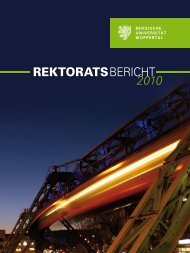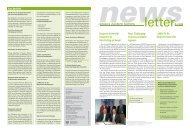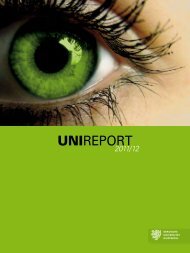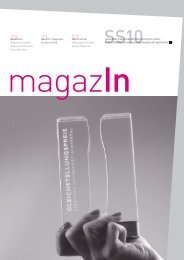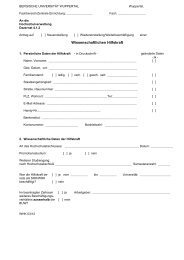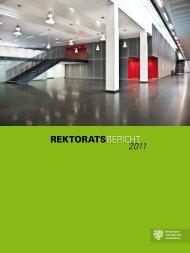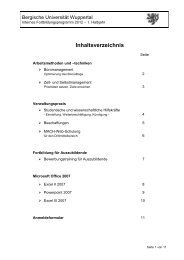international - Bergische Universität Wuppertal
international - Bergische Universität Wuppertal
international - Bergische Universität Wuppertal
Create successful ePaper yourself
Turn your PDF publications into a flip-book with our unique Google optimized e-Paper software.
60<br />
Bolivian project partners (aji = chili)<br />
Chilies – researCh against poverty<br />
José Quispe is a chili<br />
farmer. He has 2 hectares<br />
of land on a steep slope<br />
of the Bolivian Andes near<br />
Colomi. He, his wife Teófila,<br />
and their four children live<br />
from the cultivation and sale<br />
of locotos, a variety of chili<br />
widespread in the Andes. In<br />
the past this always got them<br />
through the year, but now the<br />
crop brings in too little for<br />
them to survive. They lack<br />
basic necessities: cooking oil,<br />
clothes, medicine, and school<br />
materials for the children.<br />
Because of the sparseness<br />
of the population and the distance<br />
to local markets, the<br />
Andean chili farmers do not<br />
usually sell their produce directly<br />
but to local middlemen.<br />
These can dictate the price,<br />
because the supply is relatively<br />
uniform and the market<br />
depends on two factors: the<br />
size of the annual crop and local<br />
demand.<br />
That is generally the case not<br />
only in Bolivia, but also in Peru<br />
and along the upper Amazon.<br />
An <strong>international</strong> research<br />
project of the German Federal<br />
Ministry of Economic Cooperation<br />
and Development is<br />
currently dedicated to improving<br />
the situation of the chili<br />
farmers.<br />
soMe 1.4 biLLion PeoPLe<br />
LiVe todAy in extre-<br />
Me PoVerty: in soutH<br />
AMeriCA More tHAn 120<br />
MiLLion HAVe Less tHAn<br />
tWo doLLArs A dAy<br />
The uniformity of what the<br />
farmers offer stands in sharp<br />
contrast to the biological diversity<br />
of chilies in their original<br />
habitat. In the course of<br />
the past twenty years, seed<br />
banks have been established<br />
in Bolivia and Peru to maintain<br />
the gene pool, and these<br />
state-supported programs<br />
contain more than 900 different<br />
varieties of chili. But the<br />
biodiversity present in the gene<br />
banks is deceptive, as it is<br />
used first and foremost to provide<br />
farmers with seed types<br />
that increase the yield. This,<br />
however, is not the same<br />
as increasing the farmers’ income.<br />
on the contrary, market<br />
domination by a single<br />
type of chili brings down the<br />
price and with it the income<br />
of the producer.<br />
QuALity And diVer-<br />
sity As WeAPons<br />
AGAinst PoVerty<br />
Michael Petz, Professor of<br />
Food Chemistry at the University<br />
of <strong>Wuppertal</strong>, explains<br />
that “the biodiversity of chilies<br />
can be used to improve<br />
the farmers’ income in a sustainable<br />
way”. The research<br />
project aims to identify,<br />
among the great number held<br />
by the gene banks, some 30<br />
different varieties distinguishable<br />
for their aromatic, spicy,<br />
or health-giving qualities. The<br />
sustained cultivation of these<br />
premium varieties, along with<br />
the development of regional<br />
chili-based foodstuffs like<br />
jams, dips and spreads, will,<br />
it is hoped, lead to economic<br />
improvement for the Andean<br />
chili farmers.<br />
nAturAL Wonder-<br />
WorKers<br />
Like potatoes, tomatoes and<br />
tobacco, chilies belong to<br />
the solanum or nightshade<br />
family, which includes the<br />
capsicums, the only plants to<br />
produce the intensely piquant<br />
chemical capsaicin. This is<br />
secreted in the plant’s pods,<br />
which botanically speaking<br />
are berries. Capsaicin is 300<br />
times hotter than piperine,<br />
which is responsible for the<br />
spiciness of ordinary pepper.<br />
The various species of<br />
capsicum differ markedly in<br />
piquancy, ranging from zero<br />
in vegetable capsicums,<br />
through mild in sweet paprika,<br />
to the extremely hot<br />
chilies that yield the extracts<br />
used, for example, in rheumatic<br />
plasters.<br />
Chilies are also rich in vitamin<br />
C, carotenoids and<br />
plant phenols, antioxidants<br />
that function as free radical<br />
quenchers and are therefore<br />
valued – among other<br />
components of a high vegetable<br />
and fruit diet – for their<br />
preventive medicinal properties,<br />
especially with regard<br />
to cancer, cardiac and circulatory<br />
diseases, and arteriosclerosis.<br />
They are also<br />
thought to retard the aging<br />
process.<br />
Food CHeMistry<br />
in WuPPertAL<br />
The project is coordinated<br />
by Bioversity International,<br />
a global NGo dedicated to<br />
maintaining the genetic diversity<br />
of food plants and<br />
raising the income of small<br />
farmers in developing countries.<br />
The interdisciplinary<br />
team of researchers from<br />
Germany, Peru and Bolivia<br />
includes molecular biologists<br />
responsible for the<br />
genetic characterization and<br />
selection of plant types, agriculturalists<br />
concerned with<br />
the improvement of cultivation<br />
and processing methods,<br />
and economists whose<br />
task is to determine and<br />
enhance the scope of local<br />
and <strong>international</strong> markets.<br />
UW food chemists concentrate<br />
on determining the<br />
properties and constituents<br />
of various chili types, from<br />
color, aroma and piquancy to<br />
plant phenols and vitamin C.<br />
Aroma profiles are determined<br />
by a special testing group<br />
working in isolated cabins in a<br />
pure climate room.<br />
Prof. Dr. Michael Petz<br />
Faculty of Mathematics<br />
and Natural Sciences<br />
(Food Chemistry)<br />
Tel.: +49 (0)202 439-2783<br />
E-mail petz@uni-wuppertal.de<br />
k www.lebchem.<br />
uni-wuppertal.de<br />
Research project Unraveling<br />
the Potential of Neglected<br />
Crop Diversity for High-Value<br />
Product Differentiation and<br />
Income Generation for the<br />
Poor: The Case of Chili Pepper<br />
in its Center of origin.<br />
Source of funding: Federal<br />
Ministry of Economic Cooperation<br />
and Development<br />
Total funding: €1.2 million<br />
Time frame:2010-2013<br />
Coordination: Bioversity<br />
International<br />
kwww.bioversity<strong>international</strong>.org<br />
Do or die! UW Marketing Manager Katja Indorf takes a late bite at Remscheid<br />
Research Day 2010.<br />
03_UW_RESEARCH<br />
61




